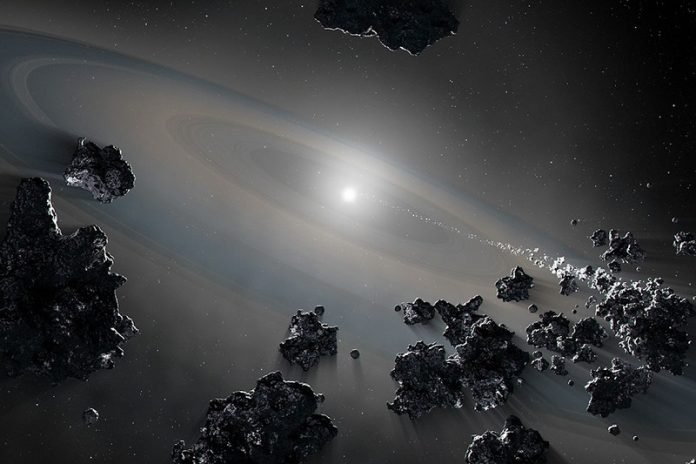
The violent death throes of a nearby star so thoroughly disrupted its planetary system that the dead star left behind — known as a white dwarf — is sucking in debris from both the system’s inner and outer reaches, UCLA astronomers and colleagues report.
This is the first case of cosmic cannibalism in which astronomers have observed a white dwarf consuming both rocky-metallic material, likely from a nearby asteroid, and icy material, presumed to be from a body similar to those found in the Kuiper belt at the fringe of our own solar system.
“We have never seen both of these kinds of objects accreting onto a white dwarf at the same time,” said lead researcher Ted Johnson, a physics and astronomy major at UCLA who graduated last week.
“By studying these white dwarfs, we hope to gain a better understanding of planetary systems that are still intact.”
The findings are based on an analysis of materials captured by the atmosphere of G238-44, a white dwarf some 86 light-years from Earth, using archival data from the Hubble Space Telescope and additional NASA satellites and observatories.
A white dwarf is the burned-out core that remains after a star like our sun sheds its outer layers and stops burning fuel through nuclear fusion.
As surprising as the white dwarf’s wide-ranging diet is, the findings are also intriguing because astronomers believe icy objects crashed into and irrigated dry, rocky planets in our solar system — including Earth. Billions of years ago, comets and asteroids are thought to have delivered water to our planet, sparking the conditions necessary for life.
The makeup of the material detected raining onto G238-44 implies that icy reservoirs might be common among planetary systems, said research co-author Benjamin Zuckerman, a UCLA professor of physics and astronomy.
“Life as we know it requires a rocky planet covered with a variety of volatile elements like carbon, nitrogen and oxygen,” Zuckerman said.
“The abundances of the elements we see on this white dwarf appear to have come from both a rocky parent body and a volatile-rich parent body — the first example we’ve found among studies of hundreds of white dwarfs.”
Chaos and destruction: From living star to red giant to white dwarf
Theories of planetary-system evolution describe the demise of a star as a turbulent, chaotic event, one that begins when it first balloons exponentially into what is known as a red giant and then quickly loses its outer layers, collapsing into a white dwarf — a super-dense star about the size of Earth, with a mass of our sun.
The process dramatically disrupts the remaining planets’ orbits, and smaller objects — asteroids, comets, moons — that venture too close to them can be scattered like pinballs and sent hurtling toward the white dwarf.
This study confirms the true scale of the chaos, showing that within 100 million years after the beginning of its white dwarf phase, the star is able to simultaneously capture and consume material from its nearby asteroid belt and its far-flung Kuiper belt–like regions.



